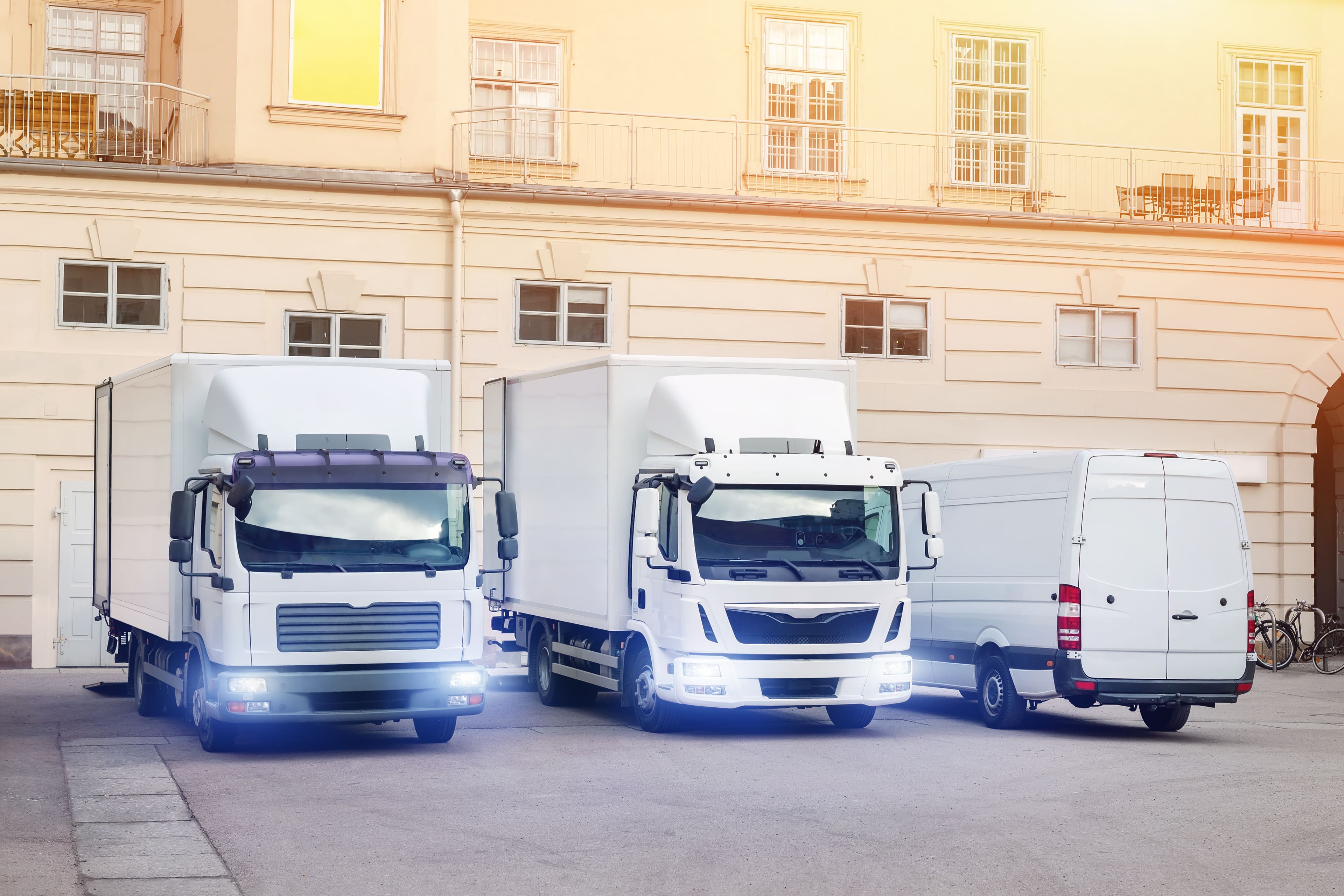- Home
- Telematics
- Vehicle tracking
- What is vehicle tracking?
Introduction to vehicle tracking
Welcome to our comprehensive guide on vehicle tracking. At Radius, we've seen first hand how vehicle tracking technology has evolved, transforming the way businesses and individuals monitor and manage their vehicles.

What is vehicle tracking?
Vehicle tracking uses GPS tracker technology combined with on-board diagnostics to provide real-time data on the location and condition of your vehicle.
Whether you're a fleet manager looking to optimise routes, a business owner aiming to improve safety, or an individual concerned about car security, vehicle tracking offers a versatile solution to meet your needs.
Why is it important?
In today's fast-paced world, staying updated with precise information about your vehicles isn't just a convenience - it's a necessity. For businesses, effective vehicle tracking means enhanced operational efficiency, reduced costs, and better service delivery. For private vehicle owners, it means peace of mind knowing your car is where it should be and that you can find it anytime, anywhere.
From our years of experience at Radius, we've seen businesses flourish by making smarter decisions based on the insights gained from vehicle tracking. For instance, a logistics company we partnered with reduced their fuel costs by 20% in just the first six months of using our tracking solutions, simply by optimising their delivery routes and reducing idle times.
What you'll learn here
This page will guide you through everything you need to know about vehicle tracking. We'll explore how it works, discuss different types of GPS tracking systems, and dive into the benefits they bring. Plus, we'll address common questions and challenges, helping you understand how to implement these systems effectively.

Looking at the hardware and software that make up vehicle tracking
Hardware: vehicle tracking devices
Vehicle tracking devices are designed for durability and reliability, catering to diverse operational needs.
These compact, easy-to-install GPS tracker devices ensure accurate and real-time location tracking, even under challenging conditions.
Our GPS tracker range includes easy to install devices that connect to the vehicle battery or ODB-II port, or hard-wired options that require professional installation.
Software specifications: accessing and using vehicle tracking information
Vehicle tracking software plays a crucial role in interpreting and using the data provided by the hardware.
Our vehicle tracking software - called Kinesis - offers a user-friendly interface that makes it easy to access vehicle data, providing comprehensive views of vehicle locations, routes, and operational statuses in real-time, with additional features for vehicle security and detailed usage reports.
This software turns raw GPS fleet tracking data into useful insights, such as identifying inefficient routes or unauthorised vehicle use. It integrates with Google Maps for a simple to use interface and display of traffic information. For example, construction firms might use these insights to reduce vehicle idle times, thereby saving fuel and minimising wear and tear on equipment.
Features of vehicle tracking software
Live map
Trip history
Driver behaviour
Geofences
Alerts
Reports

Live map
Gain a live view of the location of your vehicles and assets with our Live Map. Track the location and status of each vehicle, improving safety and security, and helping you to make informed day-to-day operational decisions.

Trip history
Use the Trip History feature to review past journeys, understanding the routes taken and how the vehicle was driven. Replay journeys to review any recorded events and optimise future routes to cut waste and reduce operating costs. If vehicle cameras are in place, download footage to gain a real-world view.

Driver behaviour
Understand how your vehicles are being driven, with detailed Driver Performance information. Identify unsafe driving habits, such as speeding, and take action. Incentivise your drivers to improve performance, cutting fuel costs and vehicle damage, whilst reducing the risk of incidents to improve safety.

Geofences
Create virtual zones around specific locations, such as company premises or customer sites. Geofences help you monitor movement into and out of locations of significance.

Alerts
Create Alerts based on geofenced locations, helping you manage your vehicles and assets proactively, protecting against vehicle misuse and theft. Receive an alert when a vehicle enters or leaves a geofenced area, either at any time of day or during specific working days or times of day.

Reports
Access a wide range of Reports that support both day-to-day business decisions and longer-term strategic choices. A number of standard reports are available, which can be customised by the vehicles included and the time period covered, or custom reports are available along with data export for more detailed analysis.
Live map

Live map
Gain a live view of the location of your vehicles and assets with our Live Map. Track the location and status of each vehicle, improving safety and security, and helping you to make informed day-to-day operational decisions.
Trip history
Driver behaviour
Geofences
Alerts
Reports
Applications of vehicle tracking across industries
Vehicle tracking systems are versatile tools that can significantly benefit businesses of all sizes, from the small fleet operation through to large national operations, needing a fleet tracking system across many vehicles. By providing precise, real-time location data, these systems help streamline operations across various industries.
Types of vehicles equipped with tracking
Vehicle tracking systems are adaptable to a wide variety of vehicles - from car tracking right through to HGVs - enhancing their utility across different sectors. Here are some typical and non-traditional vehicle type examples:
Typical vehicles:
Trucks: Essential for logistics and freight services, where tracking helps optimise delivery routes and monitor cargo security.
Vans: Commonly used by service industries such as trades for efficient dispatch and routing, and final mile delivery companies, having a van tracker can allow for route optimisation and fleet visibility
Cars: Car tracker systems are used by businesses to manage sales and service teams more effectively, with the car tracker allowing people to be directed to the next job or location.
Passenger Transport Vehicles: Includes buses and coaches used in public and private transport, where tracking ensures punctuality and safety.
Blue-Light Vehicles: Emergency vehicles like ambulances and police cars, where real-time tracking is critical for quick response times and coordination.
Vehicle Leasing and Hire Fleets: Leasing companies use tracking to monitor the location and usage of their vehicles, ensuring they are used within agreed terms and facilitating recovery if stolen.
Non-traditional examples:
Boats and Watercraft: For maritime businesses, tracking helps in navigation and fleet management.
Motorbikes: Used by delivery services and law enforcement in urban areas where navigating traffic quickly is crucial.
Agricultural Machinery: Helps in monitoring equipment like tractors and combines, crucial for large-scale farming operations.

Benefits of vehicle tracking
Vehicle tracking systems offer a multitude of advantages that extend across various aspects of fleet management and operations. The benefits are substantial for both businesses and individual users, helping to improve efficiency, security, and cost-effectiveness.
Enhanced Fleet Efficiency: Optimises routes to reduce fuel consumption and idle times, leading to lower operational costs.
Improved Safety: Monitors driver behaviour and ensures adherence to safety protocols, reducing the risk of accidents, and ensures company vehicle assets are used correctly.
Theft Prevention: Provides real-time tracking to quickly recover stolen vehicles, reducing insurance claims and potential losses.
Better Customer Service: Allows for accurate delivery tracking and estimated arrival times, enhancing customer satisfaction.
Increased Productivity: Automates record-keeping for mileage and usage, saving time and improving accuracy in reporting.
Compliance Management: Helps in adhering to regulatory requirements by providing detailed logs and reports needed for compliance audits.
Benefits for individuals:
Security and Peace of Mind: Keeps a constant eye on the vehicle’s location, offering reassurance against theft.
Cost Savings: Helps monitor and improve driving habits, potentially lowering fuel costs and insurance premiums.
Convenience: Provides easy access to vehicle diagnostics and usage statistics, simplifying maintenance scheduling.
Resale Value: Maintains a detailed history of vehicle usage and maintenance, potentially increasing the vehicle's resale value.
Emergency Assistance: Enables quick location tracking in emergency situations, speeding up the response time for assistance.

Vehicle tracking pricing overview
Understanding the pricing of vehicle tracking systems is crucial for both businesses and individual users. The cost can vary significantly depending on several factors, making it important to consider these aspects when budgeting for a GPS tracking solution. Here’s a brief overview of what influences the price and how contracts are typically structured.
Factors impacting price:
Type of Hardware: The complexity and features of the tracking device can affect the cost. Basic models are cheaper, while advanced devices with additional sensors and functionalities are more expensive.
Installation Requirements: Some systems require professional installation, which can add to the initial costs, whereas others offer easy DIY installation.
Software Features: The range of features offered by the tracking software—such as real-time tracking, detailed reporting, route optimisation, and alerts—can influence the subscription price.
Contract Length: Often, longer contracts may offer reduced rates per month compared to shorter-term agreements.
Number of Vehicles: Discounts or tiered pricing may be available depending on the number of vehicles in your fleet that need tracking.
Typical contract structure:
Vehicle tracking services are usually structured around a monthly fee that covers both the lease of the hardware and access to the fleet tracking software. This fee ensures you have ongoing support and access to the latest software updates. Contracts may include:
Setup Fee: A one-time charge for setting up the system.
Monthly Service Fee: Covers ongoing use of the software, customer support, and sometimes data storage.
Cancellation Terms: Details on how to cancel and any fees associated with early termination.
For a more detailed discussion on specific pricing models visit our telematics pricing page. Here, you'll find comprehensive information that can help you make an informed decision tailored to your budget and requirements.

Difference between vehicle tracking and asset tracking
While both vehicle tracking and asset tracking are essential components of modern fleet and asset management, they serve distinct purposes and are implemented through different technologies. Understanding the key differences between these two solutions can help you choose the right system for your specific needs.
Vehicle tracking:
Purpose: Vehicle tracking is primarily focused on monitoring vehicles in real-time. It provides comprehensive data on vehicle location, trip history, and driver performance.
Technology: This system typically uses a hardwired GPS device that integrates with the vehicle’s onboard diagnostics system. This integration allows not only for tracking but also for gathering detailed data on vehicle health and driver behaviour.
Applications: It’s particularly useful for fleet management, improving driver safety, optimising routes, reducing fuel costs, and ensuring compliance with regulatory requirements.
Data: Offers detailed insights such as route adherence, speed, idling times, and other driving patterns, which can be crucial for operational efficiency and safety audits.
Asset tracking:
Purpose: Asset tracking is generally simpler, focusing on the location tracking of various assets, which can include vehicles but also extends to equipment, tools, and other valuable items.
Technology: Uses battery-powered GPS devices that are easy to install and can be attached to almost any asset. These devices are designed for flexibility and portability, without the need for a power connection.
Applications: Ideal for theft prevention, security, and recovery of stolen assets. It’s also used to monitor the usage and location of assets that may not require constant oversight but are critical to business operations.
Data: Provides basic location data, primarily used for locating and securing assets rather than detailed monitoring of usage patterns.

Buyer’s guide: key considerations for choosing a vehicle tracking system
When choosing a GPS vehicle tracking system, define its purpose - for efficiency, safety, or monitoring. Do you need simple GPS tracking, or a wider vehicle tracking solution with richer features, and perhaps the ability to track against driver ID vs vehicle? Consider pricing models and overall cost-effectiveness to align with your budget. Verify available customer support and training for maximising system benefits.
Consider the vehicle tracking software available, in terms of the features available and how intuitive it is for fleet managers to use. Select features like real-time tracking, route optimisation, and reporting based on your needs.
Also look at the tracking device range available. Do you need something that is simple to install? Do you require certain accreditations, such as Thatcham S5 or similar.
Finally, consider other related products, such as integrated dash cams. Will this be something you want to include now or in the future, to protect drivers?
These steps lead to an informed decision, in line with your needs and requirements.

Implementation and usage tips
Getting Started: Step-by-Step Guide on Setting Up and Starting with Vehicle Tracking
To kick off your vehicle tracking implementation, start by selecting the appropriate device for your needs and preparing your vehicle fleet for installation. Schedule installations to minimise disruption to daily operations. Once the fleet tracker devices are installed, configure the software settings according to your business requirements—setting up geofences, alerts, and reporting preferences. Finally, ensure all relevant personnel are trained on how to access and use the system effectively.
Best Practices: Operational Best Practices for Fleet Managers
Fleet managers can optimise the use of vehicle tracking systems by regularly reviewing data collected to identify trends and areas for improvement. Utilise the system’s analytics to optimise routes, reduce fuel consumption, and schedule preventive maintenance. Encourage open communication with drivers about how real time tracking data will be used to support their work and enhance safety, not just monitor their actions. Consistently update system software and train staff on new features to keep the system effective and relevant.
Managing Change: Getting Buy-In from Your Business and Drivers
Implementing a new vehicle tracking system requires careful change management. Start by clearly communicating the benefits of the system to all stakeholders, including how it will help the company save money, support fleet managers and make drivers’ jobs easier and safer. Provide transparent information about what personal data will be tracked, including personal information, and how it will be used.
Engage drivers early in the process by involving them in training sessions and addressing their concerns. Demonstrating respect for their input and privacy can help foster acceptance and cooperation.

Future of vehicle tracking
The vehicle tracking industry is poised for significant growth and innovation, driven by advancements in technology and increasing demand for smarter, more efficient transportation solutions. According to a report by MarketsandMarkets, the global vehicle tracking market is expected to grow significantly, highlighting the increasing adoption of these systems across various sectors.
Emerging Trends:
Integration with IoT and Telematics: The vehicle tracking system of the future will see deeper integration with the Internet of Things (IoT) and broader telematics solutions. This integration allows for more comprehensive data collection and analytics, enabling businesses to optimise their operations more effectively than ever before.
Advanced Analytics and AI: The use of artificial intelligence (AI) in vehicle tracking systems is set to enhance the predictive capabilities of these tools. AI can help predict vehicle maintenance issues before they occur, optimise routes in real-time, and enhance driver safety features.
Increased Focus on Driver Behaviour: With advancements in technology, tracking systems are increasingly focusing on monitoring and improving driver behaviour. This includes more sophisticated alert systems for speeding, idling, and harsh driving, which can help improve safety and reduce costs.
Enhanced Security Features: As vehicle theft remains a concern, tracking systems are expected to develop more advanced security features, such as instant alerts to theft attempts and improved recovery tools using real-time tracking. These trends indicate that vehicle tracking technology is not only becoming more integrated and data-driven but also more focused on enhancing safety and efficiency. As the market continues to grow, these innovations will become increasingly accessible, providing valuable opportunities for businesses to improve their operational strategies.

Frequently asked questions
Can’t find an answer to your question? Talk to the Radius customer support team on 0800 056 4432. We’re here to help you with any questions or concerns you may have.
What is vehicle tracking?
How does vehicle tracking work?
What are the benefits of vehicle tracking for businesses?
Can vehicle tracking help reduce fuel costs?
Is vehicle tracking legal?
Glossary of Terms
GPS (Global Positioning System): A satellite-based navigation system used to determine the precise location of a vehicle.
Geofencing: A technology that creates a virtual geographic boundary, enabling software to trigger a response when a mobile device enters or leaves a particular area
Telematics: The integration of telecommunications and informatics for sending, receiving, and storing information relating to remote objects like vehicles, via telecommunication devices.
Real-time Tracking: Monitoring the location and status of a vehicle as it happens, without delay.
Route Optimisation: The process of determining the most cost-efficient route based on various factors such as distance, fuel consumption, and traffic conditions.
IoT (Internet of Things): The network of physical objects—“things”—that are embedded with sensors, software, and other technologies for the purpose of connecting and exchanging data with other devices and systems over the internet.
Predictive Maintenance: Techniques used to predict when vehicle maintenance should be performed to prevent unexpected vehicle failures.
Driver Behaviour Monitoring: Tracking and analysing driver behaviour such as speed, acceleration, and braking to improve safety and efficiency.

Partnership
Why choose Radius?
With innovative solutions built around the needs of our customers, we've established an international reputation for helping businesses grow sustainably.
Expertise
Our team has over 34 years of experience helping more than 400,000 customers globally.
Trust
We are an internationally-acclaimed provider with numerous awards for our products and services.
Choice
Choose from our range of fleet, mobility and connectivity solutions that can be tailored to suit your needs.
Solutions
Use our award-winning technology and services to save your business time and money.



Need help?
Can’t find what you are looking for?
The customer support team at Radius has a global reach with over 50 offices to offer local contact with an international presence. Let us know how we can help.
Contact us

Radius Telematics Limited is authorised and regulated by the Financial Conduct Authority under reference number 976344.